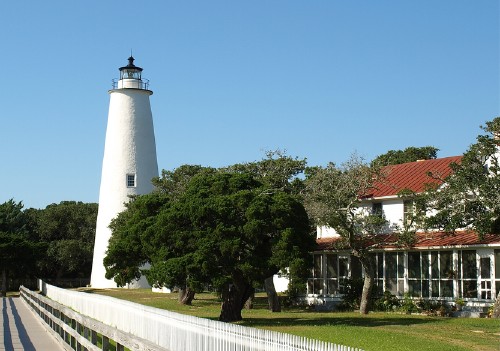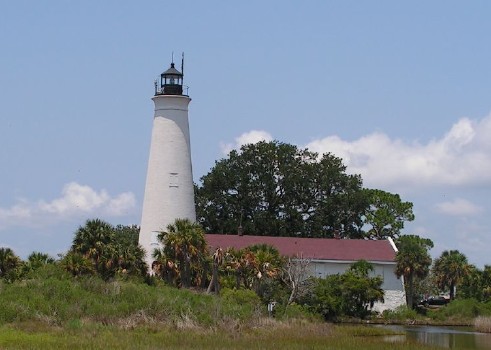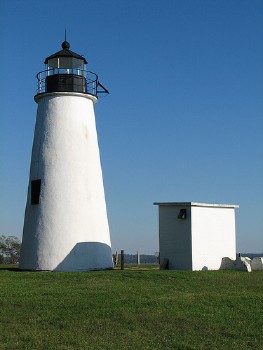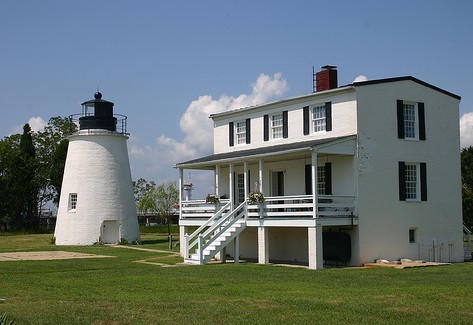Old Style Brick Lighthouses, 1820-1849
In the early days of the U.S. federal government lighthouse maintenance
was one of the tasks of the Secretary of the Treasury. In 1820
Secretary William H. Crawford delegated this responsibility to
Stephen Pleasonton, the Fifth Auditor of the Treasury. Pleasonton
served as superintendent of U.S. lighthouses until 1852. He was
a bureaucrat, with no direct knowledge of the sea, of construction,
or of lighthouse operation.
For technical expertise Pleasonton relied on Winslow Lewis (1770-1850), a former sea captain from Wellfleet, Massachusetts.
When U.S. shipping was embargoed during the Napoleonic wars
Lewis turned his attention to lighthouses and designed a new lighting
apparatus based on the Argand lamps being used at that time in
Europe. In 1812 Congress bought Lewis's patent rights for the
lighting system and awarded him a contract to equip all the country's
lighthouses with the new lamps. Four years later, after this work
was completed, Lewis won a contract to supply oil to all the light
stations and to visit them once a year to verify that they were
being properly operated.
Before long Lewis was also winning contracts to build new
lighthouses. When Pleasonton took over responsibility for these
contracts Lewis formed an alliance with him, and for three decades
a large part of the lighthouse construction in the country was
awarded to Lewis. Demand for lighthouses was high as shipping
boomed on the Atlantic coast and the Great Lakes. Funds were short.
Pleasonton took pride in his economical administration of the
lighthouses and strived to build them as cheaply as possible.
|
To meet the demand Lewis drew standard plans for conical
lighthouses in five sizes: 25, 30, 40, 50, and 65 feet high. Dozens
of these lighthouses were built, many in brick and some in stone.
However, Lewis's ignorance of engineering and Pleasonton's pinch-penny
policies made many of these lighthouses unsatisfactory: they were
too short or poorly constructed or both. Most were later pulled
down and replaced by taller, sturdier towers. Only a handful survive
today, most of them surviving because someone other than Lewis
had the contract to build them, or because Lewis happened to pick
a subcontractor who was particularly skilled in brick construction.
I refer to these lighthouses of the Pleasonton-Lewis era as "old
style."
The historic photo at right shows clearly the difference between
old style towers and the towers that replaced them after the
Lighthouse Board was appointed in 1852. The photo shows the Cape
Romain, South Carolina, light station sometime late in the nineteenth century.
On the right is the 1858 lighthouse, tall and slender, crowned
with a large lantern holding a first-order Fresnel lens. On the
left is the old style tower, a 65-foot model built by Winslow Lewis in 1827.
It is short and blunt: notice that its base is even broader than that
of the taller tower. It is topped by a "birdcage" lantern
originally designed for the Lewis lamp system.
(Both towers still stand, although the older tower has lost its lantern
and all of its paint. The newer tower was deactivated in 1947. This is
the only place in the country where old style and new style towers stand
side by side. Keith Anderson's page for Cape Romain has several recent
photos.) |
 Cape Romain Light Station, South Carolina, 1893
Cape Romain Light Station, South Carolina, 1893
U.S. National Archives photo |
 Ocracoke Light, North Carolina, September 2008
Ocracoke Light, North Carolina, September 2008
Flickr Creative Commons photo by Shayne Hiles |
One of the best-known old style brick towers is the lighthouse
at Ocracoke village on North Carolina's Outer Banks. Winslow Lewis lost
the contract for this 65-footer to Noah Porter, another New Englander.
Porter's work, completed in 1823, has held up well over the years. The
photo shows the two most characteristic features of the old style design.
The tower is bluntly conical, and the lantern is slightly off-center because
it is positioned over the top of the spiral stairway. The original birdcage
lantern is gone, replaced by a mid-nineteenth-century lantern having distinctive
trapezoidal windowpanes. The lantern was designed for a fourth order Fresnel
lens installed in 1854; this lens was replaced with another fourth order
optic in 1895, and that lens remains in use today. The tower's brickwork
was later covered with a stucco-like mortar, painted white. Several other
old style brick towers have received similar treatments.
Ocracoke Light is owned now by the National Park Service as part of the
Cape Hatteras National Seashore. The narrow, winding stairs are closed,
but visitors are allowed to enter the base of the tower. |
The lighthouse at Saint Marks on the Florida panhandle has
a history that illustrates the recurring problems of the old style lighthouses.
Winslow Lewis won the contract to build a lighthouse at the mouth of the
St. Marks River in 1829. As usual, Lewis didn't actually build the light
tower; his role in construction was to install the lantern and light apparatus.
The tower construction was subcontracted. In this case the subcontractor
cheated, building a tower with hollow walls instead of solid walls. The
local Collector of Customs refused to accept the work, and a new contractor,
Calvin Knowlton, was hired to rebuild Lewis's tower.
Knowlton's version, with solid walls, was finished in 1831. Unfortunately
the site selected (by Lewis) was too close to the Gulf, and the lighthouse
was soon threatened by beach erosion. In 1842 Lewis won a new contract
to dismantle and rebuild the tower farther inland. This was done, but
because the foundation seemed a bit shaky Lewis decided to attach the
keeper's quarters to the tower (a practice common in the North but rare
in the South). In 1865 retreating Confederate troops tried to blow up
the lighthouse and succeeded in damaging it sufficiently that it had to
be rebuilt again (for a fourth time). The 1867 reconstruction kept the
tower's old-style conical profile but added the flare at the top to support
a larger lantern, which was used for a fourth order Fresnel lens (later
replaced by a fifth order lens). These improvements increased
the tower's height to 73 ft.
Saint Marks Light is now owned by the Fish and Wildlife Service as part of the Saint Marks National Wildlife Refuge. A restoration now underway will allow the lighthouse to be opened to the public. |
 Saint Marks Light, Florida, July 2007
Saint Marks Light, Florida, July 2007
Flickr Creative Commons photo by banichiji |
 Turkey Point Light, Maryland, October 2006
Turkey Point Light, Maryland, October 2006
Flickr Creative Commons photo
by Matt Tillett |
One of the best of the builders of old style
lighthouses was John Donahoo, or Donahoe, of Havre de Grace, Maryland. Throughout
the old-style period Donahoo seems to have had a lock on the lighthouse
contracts for the Chesapeake Bay, outbidding Lewis consistently. In all
he built a dozen very sturdy lighthouses on the Chesapeake and its tributaries.
Seven of his lighthouses survive and two are still active.
Donahoo's Turkey Point Light (left), built
on the headland of Elk Neck at the northern end of the Bay, is the only
surviving example of the old-style 40-foot size that hasn't been heavily
modified. His Cove Point Light, on the Bay's western shore, is a good
example of the 50-foot size, and the little Piney Point Light (right), on the lower
Potomac River, is the only
surviving example of the 30-foot size. |

Piney Point Light, Maryland, July 2006
Flickr Creative Commons photo
by C.W. Bash
|
The following surviving lighthouses fall in the old style brick category.
Some are well known and well restored, but others are abandoned
or rarely visited. The dates and heights shown are for the original
construction. As the list reveals, the surviving lights are mostly
the taller models, and many of them were altered to make them
taller still.
- Sapelo Island, Georgia (1820, 65 ft, Winslow Lewis) - fully restored and reactivated in 1997-98, more
than a century after it was abandoned.
- Great Cumberland Island, Georgia (1820, 50 ft, Winslow Lewis) - relocated in 1838 to Amelia
Island, Florida, where it remains in use; it was restored in 2004-08.
- Ocracoke, North Carolina (1823, 65 ft, Noah Porter) - a well-loved landmark of the Outer Banks, well maintained and still in
use.
- Cape
Romain (1), South Carolina (1827, 65 ft, Winslow Lewis) - abandoned since it was replaced in 1858, this lighthouse is now gravely endangered.
- Cove Point, Maryland (1828, 50 ft, John Donahoo) - still in use, now owned and maintained by the Calvert
Marine Museum.
- St. Marks, Florida (1829, 65 ft, Calvin Knowlton- raised to 73 ft in 1867; still in use; restoration
underway.
- Fort Gratiot (Port Huron), Michigan (1829, 65 ft, Lucius Lyon) - still in use; height raised to 85 ft in 1861; restored in 2011-12.
- Turkey Point, Maryland (1832, 40 ft, John Donahoo) - deactivated by the Coast Guard in 2000 but
reactivated in 2002 by a local group working on its restoration.
- Piney
Point, Maryland (1836, 30 ft, John Donahoo) - deactivated in 1964 but carefully restored
in recent years.
- Little Cumberland
Island, Georgia (1838, 50 ft, Joseph Hastings) - deactivated in 1915 but maintained by a local
homeowners' group.
- West Sister
Island, Ohio (1848, 50 ft) - in use but stripped of its lantern.
These lighthouses started life as old-style brick towers, but they have been altered substantially by later construction:
- Cape Florida, Florida (1825, 65 ft, Noah Humphreys) - this lighthouse was rebuilt in 1846, then substantially altered and raised
to 95 ft in 1855; it was restored and reactivated in 1978.
- Key West, Florida (1825,
65 ft) - rebuilt in 1849 after being overturned by a hurricane; substantially
altered and raised to 85 ft in 1895.
Return to the Lighthouse Directory
index
Posted December 1999. Checked and revised September 23, 2018. Site copyright 2018 Russ Rowlett and the University of North Carolina
at Chapel Hill.




